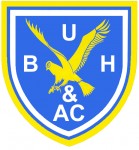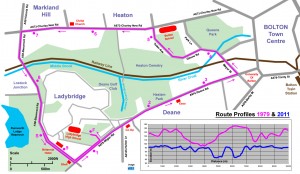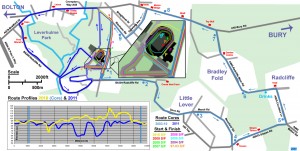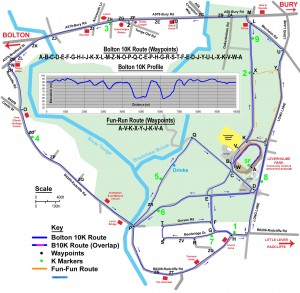BOLTON UNITED HARRIERS & AC
The Bolton 10K is hosted by Bolton United Harriers & Athletic Club, whose members have been running, jumping and throwing since 1908. We offer a friendly welcome and have now grown to over 500 active members.
Training groups for all ages (from 6 to 106!), abilities and disciplines exist, with UK Athletics-accredited coaches and volunteers offering personalised training tips. Due recognition of this fact was gained when the Clubmark was re-awarded to BUH&AC in March 2010 by England Athletics.
Club evenings are generally Tuesdays and Thursdays, with all meeting at Leverhulme Park sports centre and athletics track.
Whether you just want to get fit or improve your own times, there IS a running group for you at Bolton United Harriers! There are no “qualifying standards” and we encourage you to pop down and discover BUH&AC. Who knows, you may feel like competing for the club in local, regional, national or even international level competitions!
If you’re training for the Bolton 10K, several endurance groups meet on the track at 7pm on club evenings. Simply come down and ask for the membership secretary to direct and introduce you to the ideal one. There’s no initial charge to run with a Harriers group, so WE hope to see YOU down the track soon!
HISTORY of the BOLTON 10K
1979-1996
Bolton United Harriers & AC has an illustrious association with the 10 kilometre distance that is closely intertwined with the Bolton 10K genesis. In 1979, then BUH&AC President Jack Haslam attracted the 12th World Veterans Road Race Championship to Bolton. Over 1600 international-class runners from as far away as Argentina, Canada and Australia entered the two day event. Saturday, 21st July, saw BUH’s very own Mike Freary clock an impressive 30.00 on his way to victory in the 10km event. As if that wasn’t enough, the spritely 41-year old became a Double World Champion the very next day, powering through Sunday’s 25km race in 1hr 20mins 07secs.
The course used that weekend started on Beaumont Road (A58), just northwest of the Britannia Hotel. On turning left onto Wigan/Deane Road (A676), it continued towards the town centre, before veering north towards Bolton School via Mayor Street (B6202), Gilnow Road and Tudor Avenue. Chorley New Road (A673) was followed due west to the junction with Beaumont Road, whereupon the route lapped the start and found its way to the finish area on a tarmac path between the sports fields of Ladybridge High School (then Deane School) via Back Wigan Road North. Two loops of this course (with the first lap extending to Lostock Junction Lane, Tempest Road and Lock Lane) formed the 25km route. Inset within the route map below, a comparison of the profile with that of the 2011-introduced course shows just how ‘undulating’ the old route was.
Click on the 1979-88 ROUTE MAP for a larger version. Alternatively, download the 1979-88 map in PDF format HERE.
BUH&AC’s Ken Fowler and Paul Rimmer then assisted Jack in establishing this route as the Reebok 10K Road Race from 1982. The largest turn-out apparently coincided with the Sports Aid event in 1984, which proved to be an early forerunner to mass-participation charity runs. It is believed the course record (28.05) was set by Steve Jones, the former World Marathon Record holder and member of Reebok Running Club, in 1983. Bernie Ford of Aldershot ran 29.37 in June 1984, whilst Wirral AC’s Mike Capper (29.44) beat a field of 668 runners (including 86 BUH members) in 1985. Horwich RMI’s Paul Dugdale proved to be this route’s last winner in 1988, as concerns about policing the traffic levels and several major road junctions forced a rethink.
The annual Bolton Show (since re-launched as Bolton’s One Big Weekend), which had been held at BUH&AC’s Leverhulme Park base since its reintroduction in 1981, provided the ideal impetus for Ken. Supported by Bolton Sports Council, he presided over the route switch in 1989 and renamed it the Bolton Festival 10K (it took place on the same weekend in August). Eddie Simpson was the inaugural winner, with the route very similar to the 1997-2010 core described below. Unfortunately, the Bolton 10K per se experienced several years ‘in the wilderness’ during the mid-1990s, though a 10km road run did appear as part of the biannual “Bolton Blast” duathlon (held in March and October). Precious little from this early period survives, but if you have any information about the Bolton 10K’s development during the 1980s, please ‘Send Us A Message’ using the widget in CONTACT US.
1997-2010
In 1997, Nick Howarth resurrected the Bolton 10K in its current form to coincide with the London Marathon – a relatively free weekend in the local race calendar as people focussed on the ‘jog’ in the Capital. Prior to the Millennium, the majority of participants were club runners (75% in 1997), but the turn of the Century saw a boom in running in general. By the early ‘Noughties’, unaffiliated runners were forming a greater proportion of race fields and the Bolton 10K, no different to the trend, had trebled in size in six years (30% club runners in 2003). Hence minor changes to the course were made to accommodate this increase.
Click on the 1997-2010 ROUTE MAP for a larger version. Alternatively, download the 1997-2010 map in PDF format HERE.
The core of the route wound its way from the Leverhulme Park area to Little Lever via Radcliffe Road. Skirting the edge of Radcliffe and Bradley Fold, the stand-out feature was ”that hill” up to the 7km mark, before a welcome downhill along Bury Road returned the runners to the athletics track. The various incarnations to the start and finish are shown on the graphic above, and for comparison, the profile of the 2010 route (core between the 1km and 9.5km mark) is displayed alongside that of the 2011 course.
The last start on the park road near ‘Spooky Hill’ was in 2004. That year, the race was dedicated to Ian Hales, a BUH&AC committee member, runner and coach who died in a tragic accident whilst on holiday. In 2005, the entry limit of 750 was reached for the first time and the start was switched to the newly renovated athletics track. However, a number of unexpected logistical issues were experienced and the start was moved again in 2006 to Long Lane. The end of the decade saw the introduction of chip timing and greater consideration being given to runners’ safety, so the route underwent another mutation with the start shifting to the Blenheim Road area. All the routes finished on the athletics track, but invariably took different paths (literally!) to get there!
These small but important differences mean no one person can claim to hold THE Bolton 10K record. Indeed, 2004’s run was slightly shy of 10km, the start having been moved forward 150m to avoid a huge ‘puddle’ that had appeared from overnight rain – PBs set that year don’t count! However, a comprehensive list of all open-age and category winners is shown in the Results section – consider this our Hall Of Fame!
2011 – Present
After over a decade of organising the Bolton 10K virtually single-handedly, its future was looking ominous after the 2010 event. Nick’s previous ‘retirement’ in 2008 was short-lived; his dedication ensured the race remained a fixture in running diaries for another two years, despite also taking on considerable responsibilities in his role as Club President. Seeing such an established event drop off the calendar would have been a great loss for North West runners, so an Organising Committee came together in the following summer months led by Steve Houghton. In no particular order (well, go on then, alphabetically!), the group includes Andrew Doyle, Daryl Bentley, Keith Mallinder and Nick Howarth. As you may have noticed, a familiar name is present and due credit for his wholehearted commitment is hereby given!
Various factors necessitated a complete route change for 2011. Given its popularity, maintaining the traditional core route, which crossed two major road intersections, was becoming unworkable without road closures. Furthermore, the route actually impinged on highways belonging to both Bolton Council and Bury Council; logistically, it was not viable to continue this arrangement. The 2011 course was established to take advantage of a parkland setting and minimised risks to runners by using left turns on all highways.
Click on the 2011 ROUTE MAP for a larger version. Alternatively, download the 2011 map in PDF format HERE.
After exiting the track, winding its way around the car park and joining Long Lane via Radcliffe Road at the 1km mark, the 2011 route dropped past the athletics track, and entered the park with a ‘dogleg’ up the central path. At the police station after 2km, it turned onto Bury Road and gently climbed uphill to the Wesleyan Trinity Chapel (built in 1886) at the crest. This 3km point features a curious sculpture made from brushed stainless steel with illuminating interior panels. Linked to the Methodist Church, its form represents the two local streams and an oak tree leaf. It then descended past a number of car forecourts and an almost unwitting crossing of the River Tonge, before baring left onto Bradford Street. A sharp left past the Esso/Tesco garage into Radcliffe Road intersected Castle Street at 3.8km, passing the former home (now heritage centre) of the late Fred Dibnah, Bolton’s legendary steeplejack, before an ever-increasing gradient descent past St Stephen & All Martyrs church ended at the lower entrance of Leverhulme Park. A ‘triangle’ of flat parkland track, the steep 250m up Cinder Hill and 350m down Spooky Hill was navigated before the ‘reward’ of a sweeping 700m-long climb along Radcliffe Road completed the ‘Big W’ of the route’s profile. A brief trot through the Bembridge Drive residential area took runners back to Long Lane for a final flat 2km.
Despite this, various marshalling issues were encountered, so a further route change was made for 2012’s race. Virtually entirely car-free, competitors are always within 1km of the start point and the nice scenery has been kept! With the route also being two laps, there are plenty of opportunities for spectating friends and relatives to cheer on the runners several times from the same point. It proved to be a good mix, as the race’s popularity went from strength to strength with the entry limits being reached every year thereafter. As was the case with his predecessor, Steve Houghton’s ‘retirement’ after the 2016 race lasted barely months; the 2017 event went ahead and was acknowledged as the “best yet”, with course records being set in both the men’s and women’s race. However, this staging really was to be the final race organised solely by Steve Houghton and its future was decidedly uncertain! In December 2017, Gail Harrison stepped forward to take over the reins with the assistance of Nicky Cartridge and Frazer Jardine, and guiding input from SH, thereby ensuring BUH&AC’s reputation for staging this superb event can continue.
Unfortunately, the one aspect of the race that cannot be organised is the weather! Whilst 2011’s race came in the midst of a mini-heatwave (hard to believe in the North-west), 2012’s event featured monsoon-like rainy conditions that rendered the course, in parts, more akin to a steeplechase! Despite this, feedback was overwhelmingly positive, with the field reaching its entry limit by mid-April. Moral of the history story – enter early to avoid disappointment!
DISCLAIMER
All images and content is owned by Bolton 10K and BUH&AC, except those where acknowledgement is given and permission granted. All logos are owned by their respective companies and organisations, and used with their permission. All photographs are credited to the takers where ownership is known. Credits to Keith Mallinder and Steve Houghton for website design, programming and content. Whilst we have tried to ensure the accuracy of all content and sought permission to use any third-party data, we accept there may be some inconsistencies. If there is any issue with any part of the website, the volunteers at Bolton 10K will be happy to discuss, accommodate and, if necessary, amend any reference.




